Red Lasers
Definition: lasers emitting red light
More general term: visible lasers
German: rote Laser
How to cite the article; suggest additional literature
Author: Dr. Rüdiger Paschotta
This article deals with lasers emitting in the red spectral region, i.e. with a wavelength roughly around 625–700 nm. The following types of red lasers are the most common:
- Red laser diodes, based on, e.g., GaInP or AlGaInP quantum wells, are available with different output power levels, ranging from a few milliwatts (single emitters, VCSELs) to the order of 100 W from diode bars. Typical wavelengths are 635, 650 and 670 nm. The shorter wavelengths have significantly better visibility for the human eye, but are more difficult to generate efficiently. Red laser diodes are often used for laser pointers.
- Various gas lasers can emit red light. In particular, helium–neon lasers are suitable for smaller powers at 632.8 nm, whereas krypton lasers can generate high powers at 647.1 nm.
- Lasers based on praseodymium-doped (and sometimes ytterbium-codoped) ZBLAN fibers can emit around 635 nm. Hundreds of milliwatts of output power and very high beam quality are achievable. It is also possible to realize upconversion lasing.
- Red bulk lasers can be based on, e.g., laser crystals of ruby (chromium-doped sapphire, Cr3+:Al2O3), and also on Pr3+:YLF and Pr3+:LiLuF4 [8]. Titanium–sapphire lasers emit mostly in the infrared region, but can be tuned down to roughly 650 nm.
- There are various types of frequency-doubled lasers, where the actual laser emits in the 1.2–1.3-μm spectral region and a frequency doubler converts this radiation into red light. For example, 660-nm light can be generated with frequency-doubled Nd:YAG lasers, 656.5 nm with Nd:YLF, or 671 nm with Nd:YVO4 or Nd:GdVO4. Output powers of multiple watts can be obtained with high beam quality.
- Some red laser sources are based on other nonlinear frequency conversion devices, involving e.g. sum frequency generation or parametric oscillation. For example, an OPO with intracavity sum frequency generation can generate red light [3].
- There are optically pumped semiconductor lasers (VECSELs) which can either directly emit red light [5], or generate red light via intracavity second-harmonic generation [7].
Light from lasers operating at somewhat longer wavelengths, such as 750 or even 800 nm, can still be perceived as red light, if it is sufficiently intense. (There is no sharp boundary between the visible and the infrared spectral regions.) It can, however, be hazardous to view such light, because such intensity levels required for good visibility can damage the retina.
Red lasers are applied e.g. as laser pointers, for optical data recording or retrieval (e.g. on DVDs), for laser projection displays, for interferometers, for pumping of certain solid-state lasers (e.g. Cr:LiSAF or Cr:LiCAF), and in medical therapies (e.g. photodynamic therapy).
Suppliers
The RP Photonics Buyer's Guide contains 75 suppliers for red lasers. Among them:

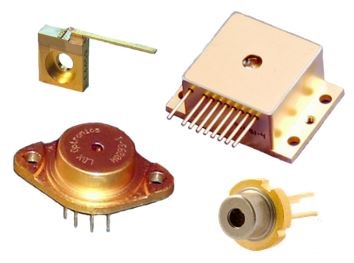
RPMC Lasers
RPMC Lasers offers a wide range of red diode and DPSS lasers between 620 nm and 699 nm. We offer pulsed and CW lasers and modules with packaging at all levels of integration from TO can through turnkey system.

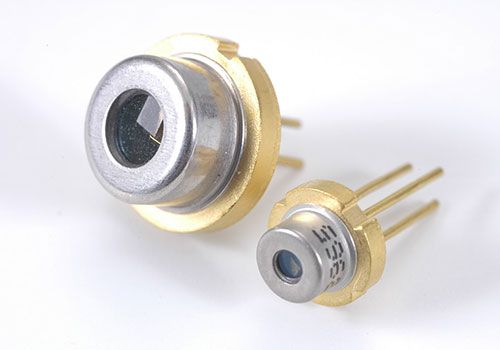
TOPTICA Photonics
TOPTICA offers a large variety of wavelength-selected single-mode laser diodes. Among more standard laser diodes you will also find "rarities", i.e. diodes with output wavelengths that only TOPTICA provides. The diodes can be purchased separately. In addition TOPTICA can integrate any diode from the stock lists into a tunable diode laser system: Fabry–Perot or AR-coated laser diodes may be integrated into a diode laser systems, DFB/DBR laser diodes into a DFB pro and Tapered Amplifier into an TA system.
Each type of diode is carefully tested in an external cavity laser configuration with respect to coarse tuning range, mode-hop-free tuning range and power limits. The results are disclosed on request to the customer in a detailed datasheet. In case you can still not match your wavelength of choice, contact TOPTICA – and chances are very high that we can provide it within very short time.
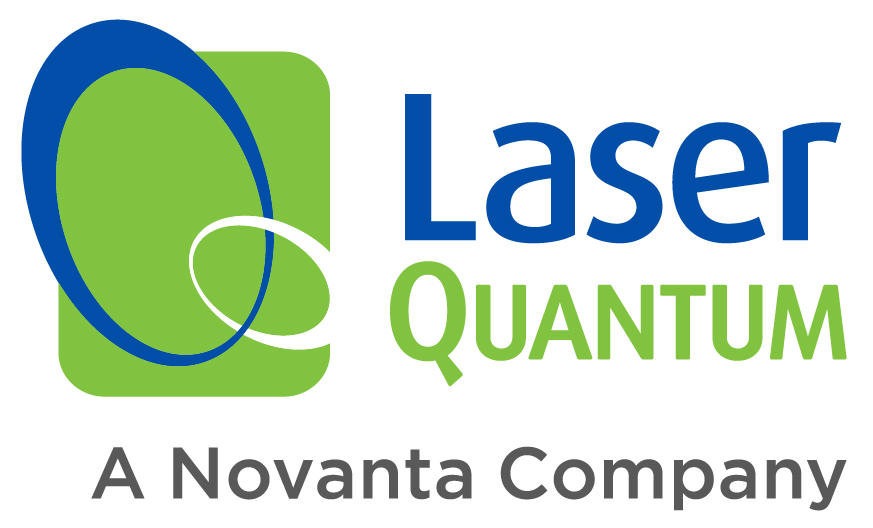

Laser Quantum
Laser Quantum manufacture a wide range of 660 nm and 671 nm red lasers for applications such as DNA sequencing, FLIM, Raman imaging and for de-excitation in super resolution microscopy.

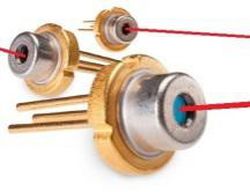
Frankfurt Laser Company
Frankfurt Laser Company offers red laser diodes with emission wavelengths from 620 nm to 700 nm.

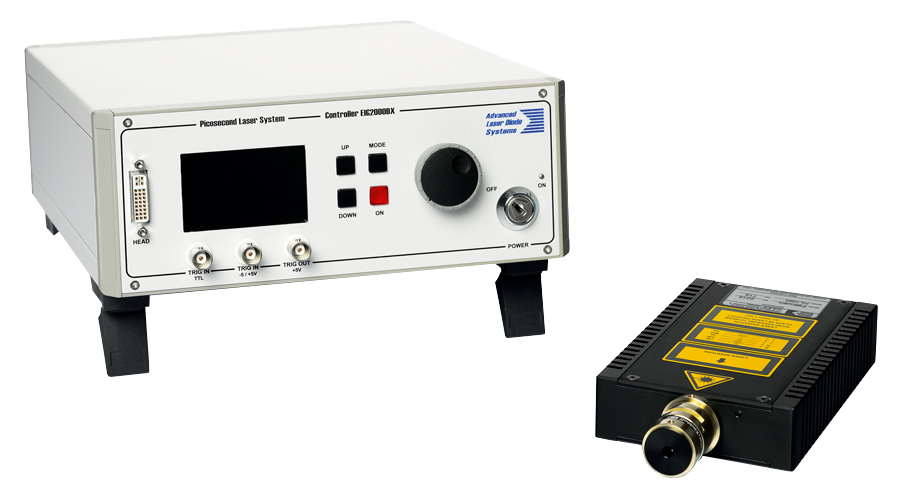
NKT Photonics
As part of our PILAS range of gain-switched pulsed diode lasers, we offer two different red lasers: The PiL063 with a wavelength of 635 nm and the Pil067 with a wavelength of 665 nm. All PILAS lasers offer triggable pulses down to 20 ps in a small footprint for both scientific and OEM applications. Available with output wavelengths from 375 nm to 1.6 μm, the PILAS lasers are very versatile and comes with low timing jitter, maintenance-free operation, and low cost of ownership.


Edmund Optics
Edmund Optics offers different kinds of red lasers, including diode lasers and diode-pumped semiconductor lasers.
Questions and Comments from Users
Here you can submit questions and comments. As far as they get accepted by the author, they will appear above this paragraph together with the author’s answer. The author will decide on acceptance based on certain criteria. Essentially, the issue must be of sufficiently broad interest.
Please do not enter personal data here; we would otherwise delete it soon. (See also our privacy declaration.) If you wish to receive personal feedback or consultancy from the author, please contact him e.g. via e-mail.
By submitting the information, you give your consent to the potential publication of your inputs on our website according to our rules. (If you later retract your consent, we will delete those inputs.) As your inputs are first reviewed by the author, they may be published with some delay.
Bibliography
| [1] | H. B. Seereze and C. M. Harding, “100 W 671 nm visible laser diode array”, Electron. Lett. 28 (23), 2115 (1992), doi:10.1049/el:19921357 |
| [2] | B. Lu et al., “400 mW continuous-wave diffraction limited flared unstable resonator laser diode at 635 nm”, Electron. Lett. 33, 1633 (1997), doi:10.1049/el:19971115 |
| [3] | W. R. Bosenberg et al., “2.5-W, continuous-wave, 629-nm solid-state laser source”, Opt. Lett. 23 (3), 207 (1998), doi:10.1364/OL.23.000207 |
| [4] | Sun et al., “Generation of 11.5 W coherent red-light by intra-cavity frequency-doubling of a side-pumped Nd:YAG laser in a 4-cm LBO”, Opt. Commun. 241, 167 (2004), doi:10.1016/j.optcom.2004.06.063 |
| [5] | J. E. Hastie et al., “High power CW red VECSEL with linearly polarized TEM00 output”, Opt. Express 13 (1), 77 (2004), doi:10.1364/OPEX.13.000077 |
| [6] | C. Du et al., “6-W diode-end-pumped Nd:GdVO4/LBO quasi-continuous-wave red laser at 671 nm”, Opt. Express 13 (6), 2013 (2005), doi:10.1364/OPEX.13.002013 |
| [7] | A. Härkönen et al., “High power frequency doubled GaInNAs semiconductor disk laser emitting at 615 nm”, Opt. Express 15 (6), 3224 (2007), doi:10.1364/OE.15.003224 |
| [8] | A. Richter et al., “Power scaling of semiconductor laser pumped praseodymium-lasers”, Opt. Express 15 (8), 5172 (2007), doi:10.1364/OE.15.005172 |
| [9] | P. Adamiec et al., “Tapered lasers emitting at 650 nm with 1 W output power with nearly diffraction-limited beam quality”, Opt. Lett. 34 (16), 2456 (2009), doi:10.1364/OL.34.002456 |
See also: lasers, helium–neon lasers, laser diodes, frequency doubling, blue lasers, green lasers, yellow and orange lasers, laser pointers
and other articles in the category lasers
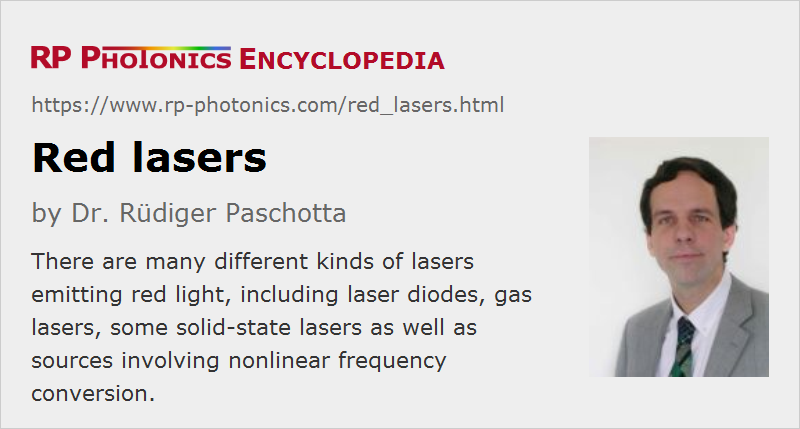 |




If you like this page, please share the link with your friends and colleagues, e.g. via social media:
These sharing buttons are implemented in a privacy-friendly way!